Maximizing Return on People: HRM Strategy at Eagle Eye Solutions
VerifiedAdded on 2022/11/28
|13
|3393
|451
Report
AI Summary
This report provides a comprehensive analysis of Human Resource Management (HRM) strategies, focusing on their application within Eagle Eye Solutions Limited, a UK-based IT company. It begins by defining HRM and its core concepts, emphasizing its crucial role in organizational performance, employee development, and talent management. The report then examines the specific HRM strategy employed by Eagle Eye Solutions, including the implementation of a Human Capital Management (HCM) survey to assess employee satisfaction, leadership practices, and organizational learning. The analysis highlights how the HCM survey can be utilized to identify areas for improvement and optimize workforce performance. The report also discusses the importance of aligning HRM practices with organizational goals and the iterative process of evaluating and adjusting HCM strategies to drive continuous improvement. The findings underscore the significance of employee engagement, knowledge accessibility, and workforce optimization in achieving higher organizational performance. Finally, it concludes with a discussion of how Eagle Eye Solutions can leverage the HCM survey to enhance its HRM practices and overall business outcomes.
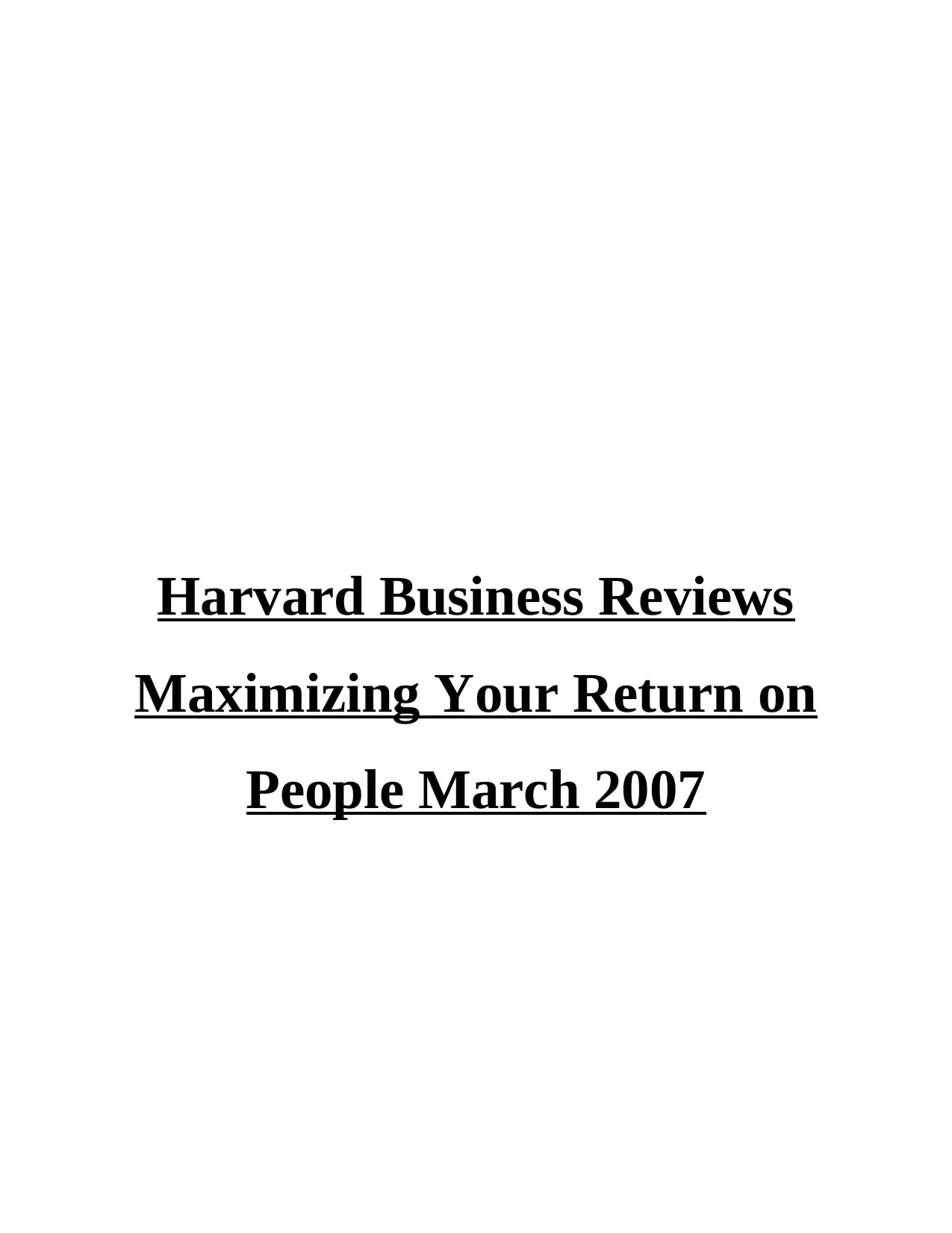
Harvard Business Reviews
Maximizing Your Return on
People March 2007
Maximizing Your Return on
People March 2007
Paraphrase This Document
Need a fresh take? Get an instant paraphrase of this document with our AI Paraphraser
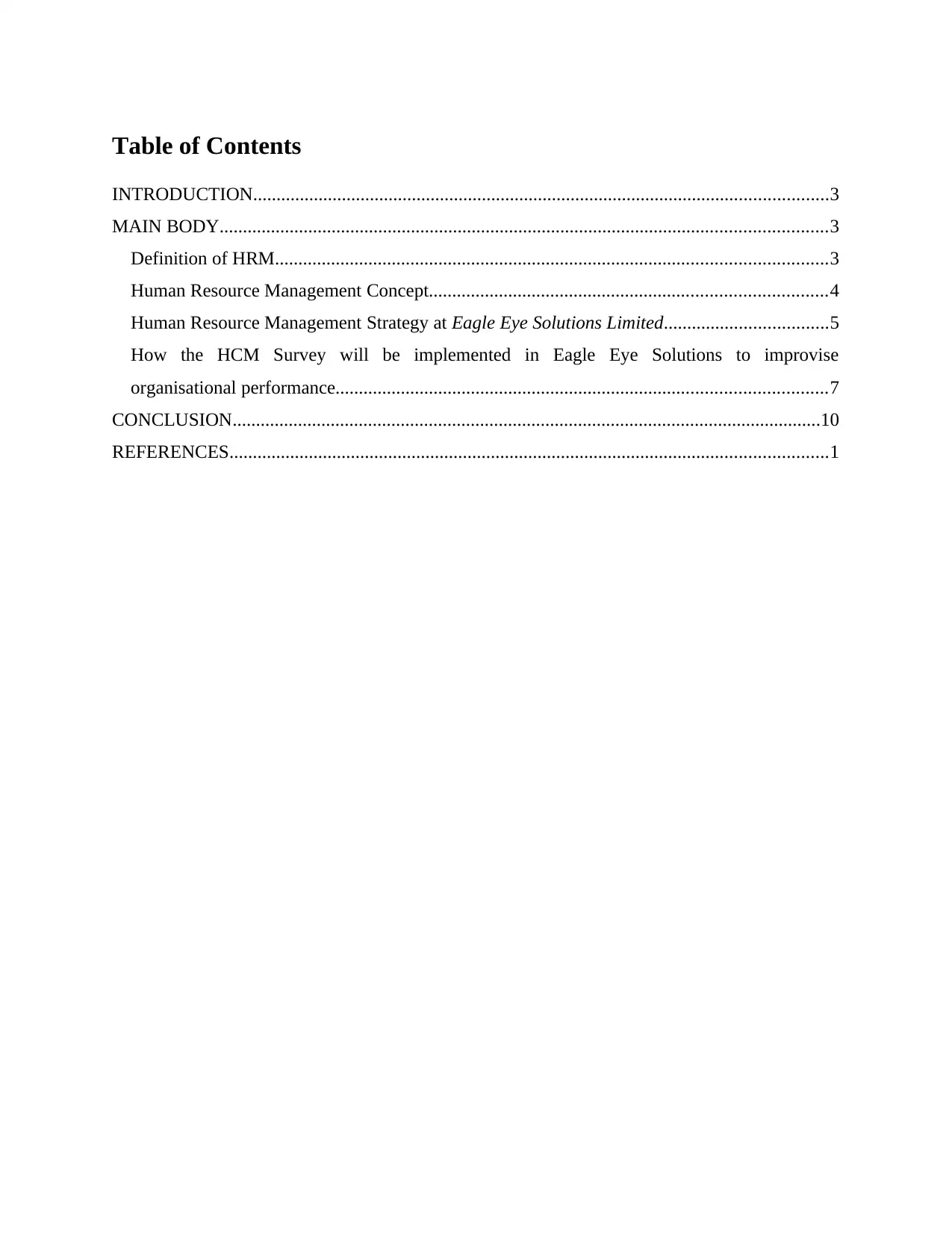
Table of Contents
INTRODUCTION...........................................................................................................................3
MAIN BODY..................................................................................................................................3
Definition of HRM......................................................................................................................3
Human Resource Management Concept.....................................................................................4
Human Resource Management Strategy at Eagle Eye Solutions Limited...................................5
How the HCM Survey will be implemented in Eagle Eye Solutions to improvise
organisational performance.........................................................................................................7
CONCLUSION..............................................................................................................................10
REFERENCES................................................................................................................................1
INTRODUCTION...........................................................................................................................3
MAIN BODY..................................................................................................................................3
Definition of HRM......................................................................................................................3
Human Resource Management Concept.....................................................................................4
Human Resource Management Strategy at Eagle Eye Solutions Limited...................................5
How the HCM Survey will be implemented in Eagle Eye Solutions to improvise
organisational performance.........................................................................................................7
CONCLUSION..............................................................................................................................10
REFERENCES................................................................................................................................1
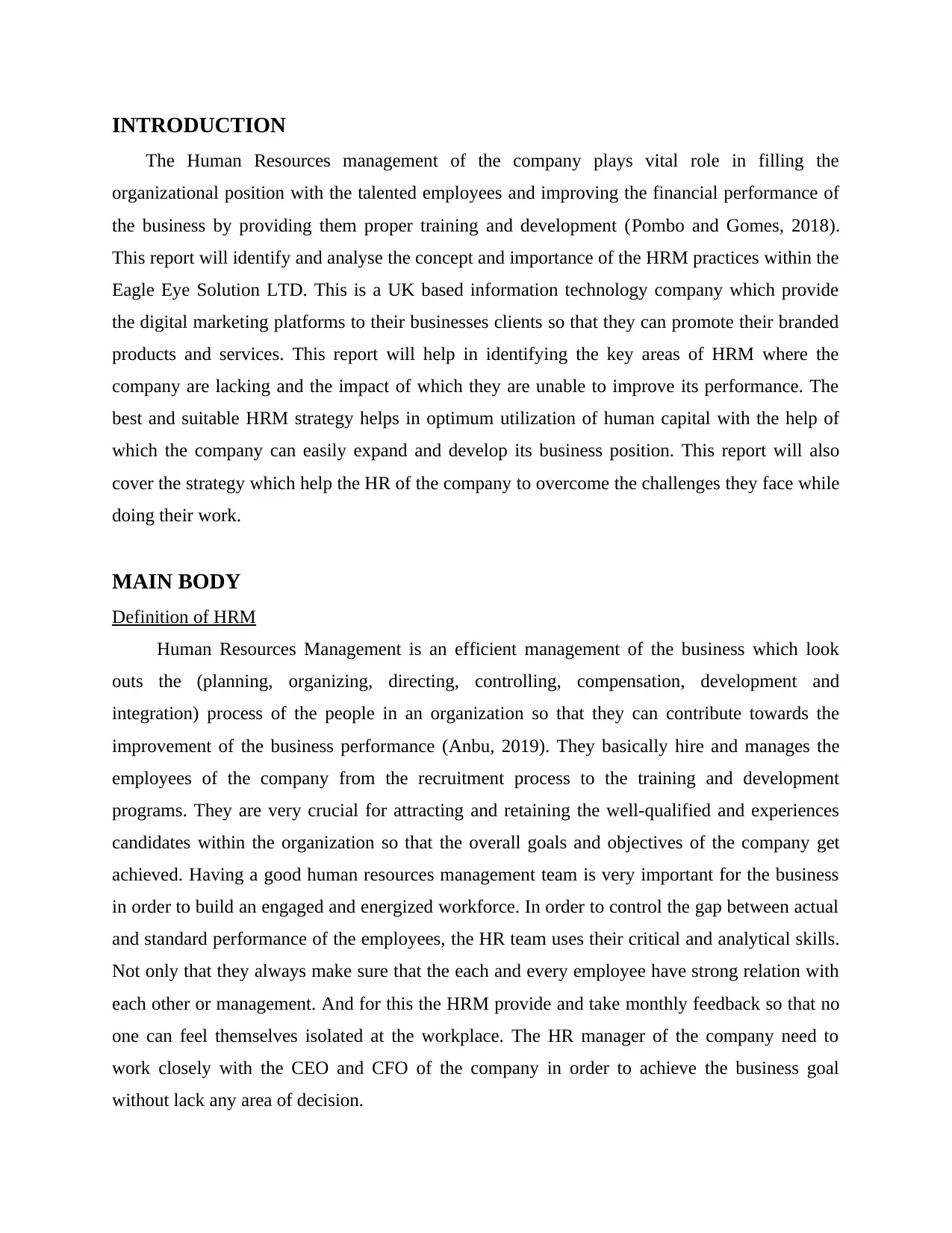
INTRODUCTION
The Human Resources management of the company plays vital role in filling the
organizational position with the talented employees and improving the financial performance of
the business by providing them proper training and development (Pombo and Gomes, 2018).
This report will identify and analyse the concept and importance of the HRM practices within the
Eagle Eye Solution LTD. This is a UK based information technology company which provide
the digital marketing platforms to their businesses clients so that they can promote their branded
products and services. This report will help in identifying the key areas of HRM where the
company are lacking and the impact of which they are unable to improve its performance. The
best and suitable HRM strategy helps in optimum utilization of human capital with the help of
which the company can easily expand and develop its business position. This report will also
cover the strategy which help the HR of the company to overcome the challenges they face while
doing their work.
MAIN BODY
Definition of HRM
Human Resources Management is an efficient management of the business which look
outs the (planning, organizing, directing, controlling, compensation, development and
integration) process of the people in an organization so that they can contribute towards the
improvement of the business performance (Anbu, 2019). They basically hire and manages the
employees of the company from the recruitment process to the training and development
programs. They are very crucial for attracting and retaining the well-qualified and experiences
candidates within the organization so that the overall goals and objectives of the company get
achieved. Having a good human resources management team is very important for the business
in order to build an engaged and energized workforce. In order to control the gap between actual
and standard performance of the employees, the HR team uses their critical and analytical skills.
Not only that they always make sure that the each and every employee have strong relation with
each other or management. And for this the HRM provide and take monthly feedback so that no
one can feel themselves isolated at the workplace. The HR manager of the company need to
work closely with the CEO and CFO of the company in order to achieve the business goal
without lack any area of decision.
The Human Resources management of the company plays vital role in filling the
organizational position with the talented employees and improving the financial performance of
the business by providing them proper training and development (Pombo and Gomes, 2018).
This report will identify and analyse the concept and importance of the HRM practices within the
Eagle Eye Solution LTD. This is a UK based information technology company which provide
the digital marketing platforms to their businesses clients so that they can promote their branded
products and services. This report will help in identifying the key areas of HRM where the
company are lacking and the impact of which they are unable to improve its performance. The
best and suitable HRM strategy helps in optimum utilization of human capital with the help of
which the company can easily expand and develop its business position. This report will also
cover the strategy which help the HR of the company to overcome the challenges they face while
doing their work.
MAIN BODY
Definition of HRM
Human Resources Management is an efficient management of the business which look
outs the (planning, organizing, directing, controlling, compensation, development and
integration) process of the people in an organization so that they can contribute towards the
improvement of the business performance (Anbu, 2019). They basically hire and manages the
employees of the company from the recruitment process to the training and development
programs. They are very crucial for attracting and retaining the well-qualified and experiences
candidates within the organization so that the overall goals and objectives of the company get
achieved. Having a good human resources management team is very important for the business
in order to build an engaged and energized workforce. In order to control the gap between actual
and standard performance of the employees, the HR team uses their critical and analytical skills.
Not only that they always make sure that the each and every employee have strong relation with
each other or management. And for this the HRM provide and take monthly feedback so that no
one can feel themselves isolated at the workplace. The HR manager of the company need to
work closely with the CEO and CFO of the company in order to achieve the business goal
without lack any area of decision.
⊘ This is a preview!⊘
Do you want full access?
Subscribe today to unlock all pages.

Trusted by 1+ million students worldwide
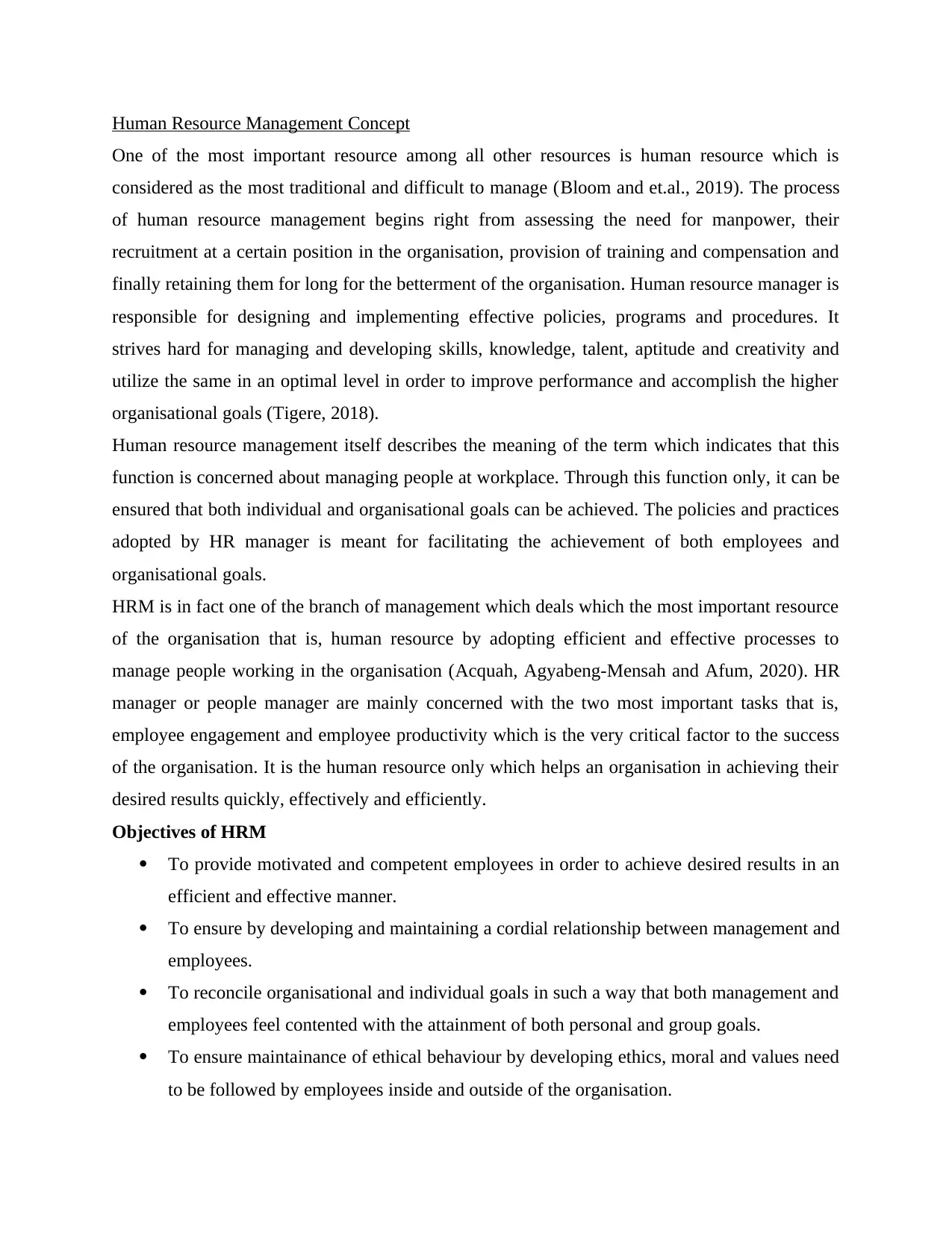
Human Resource Management Concept
One of the most important resource among all other resources is human resource which is
considered as the most traditional and difficult to manage (Bloom and et.al., 2019). The process
of human resource management begins right from assessing the need for manpower, their
recruitment at a certain position in the organisation, provision of training and compensation and
finally retaining them for long for the betterment of the organisation. Human resource manager is
responsible for designing and implementing effective policies, programs and procedures. It
strives hard for managing and developing skills, knowledge, talent, aptitude and creativity and
utilize the same in an optimal level in order to improve performance and accomplish the higher
organisational goals (Tigere, 2018).
Human resource management itself describes the meaning of the term which indicates that this
function is concerned about managing people at workplace. Through this function only, it can be
ensured that both individual and organisational goals can be achieved. The policies and practices
adopted by HR manager is meant for facilitating the achievement of both employees and
organisational goals.
HRM is in fact one of the branch of management which deals which the most important resource
of the organisation that is, human resource by adopting efficient and effective processes to
manage people working in the organisation (Acquah, Agyabeng-Mensah and Afum, 2020). HR
manager or people manager are mainly concerned with the two most important tasks that is,
employee engagement and employee productivity which is the very critical factor to the success
of the organisation. It is the human resource only which helps an organisation in achieving their
desired results quickly, effectively and efficiently.
Objectives of HRM
To provide motivated and competent employees in order to achieve desired results in an
efficient and effective manner.
To ensure by developing and maintaining a cordial relationship between management and
employees.
To reconcile organisational and individual goals in such a way that both management and
employees feel contented with the attainment of both personal and group goals.
To ensure maintainance of ethical behaviour by developing ethics, moral and values need
to be followed by employees inside and outside of the organisation.
One of the most important resource among all other resources is human resource which is
considered as the most traditional and difficult to manage (Bloom and et.al., 2019). The process
of human resource management begins right from assessing the need for manpower, their
recruitment at a certain position in the organisation, provision of training and compensation and
finally retaining them for long for the betterment of the organisation. Human resource manager is
responsible for designing and implementing effective policies, programs and procedures. It
strives hard for managing and developing skills, knowledge, talent, aptitude and creativity and
utilize the same in an optimal level in order to improve performance and accomplish the higher
organisational goals (Tigere, 2018).
Human resource management itself describes the meaning of the term which indicates that this
function is concerned about managing people at workplace. Through this function only, it can be
ensured that both individual and organisational goals can be achieved. The policies and practices
adopted by HR manager is meant for facilitating the achievement of both employees and
organisational goals.
HRM is in fact one of the branch of management which deals which the most important resource
of the organisation that is, human resource by adopting efficient and effective processes to
manage people working in the organisation (Acquah, Agyabeng-Mensah and Afum, 2020). HR
manager or people manager are mainly concerned with the two most important tasks that is,
employee engagement and employee productivity which is the very critical factor to the success
of the organisation. It is the human resource only which helps an organisation in achieving their
desired results quickly, effectively and efficiently.
Objectives of HRM
To provide motivated and competent employees in order to achieve desired results in an
efficient and effective manner.
To ensure by developing and maintaining a cordial relationship between management and
employees.
To reconcile organisational and individual goals in such a way that both management and
employees feel contented with the attainment of both personal and group goals.
To ensure maintainance of ethical behaviour by developing ethics, moral and values need
to be followed by employees inside and outside of the organisation.
Paraphrase This Document
Need a fresh take? Get an instant paraphrase of this document with our AI Paraphraser

To compensate, appraise, train and develop employees for the better performance of the
organisation (Chaudhuri, Hirudayaraj and Ardichvili, 2018).
To undertake HR planning to ensure right number of employees are available in the
organisation as required for the accomplishment of organisational tasks, and that too
these employees must be placed at the right position and at the right time.
Scope - Human Resource Management
The scope of HRM revolves around the four major tasks performed by HR manager that is,
acquiring, developing, maintaining and controlling the human dimension of an organisation.
Under the task of acquisition, the activities performed are conducting human resource
planning (HRP) and accordingly recruiting, selecting and placing employees to the vacant
position in the organisation.
While developing workforce in the organisation, HR manager resorts to providing
training, career development opportunities to employees both organisational and individual
development and also performs the task of moving employees internally from one job position to
another (Akoi and Yesiltas, 2020).
For maintainance of talented and efficient workforce within the organisation, HR
manager performs the tasks such as providing remuneration to employees, motivational tools,
health and safety measures, social security, better industrial relations and undertake to appraise
their performance from time to time.
And the last one is controlling human resource of an organisation by conducting audit
and accounting of human resource through human resource information system (HRIS) to ensure
that the employees in the organisation are performing well and up to the level that is required for
the attainment of higher organisational goals.
Human Resource Management Strategy at Eagle Eye Solutions Limited
The strategy adopted by HR manager is meant for developing and implementing those human
resource programs that are needed for solving and addressing problems of the business and thus
contributed towards the major long term objectives of the business (Hussinki and et.al., 2017).
HR strategy involves mission and vision of the HR department of an organisation and the high
level actions required to fulfil the stated mission and vision of HRD.
Here in the context of Eagle Eye Solutions, the discussion pertaining HR strategy will be done
through the HCM survey tool which will be utilized for studying HRM status of Eagle Eye, how
organisation (Chaudhuri, Hirudayaraj and Ardichvili, 2018).
To undertake HR planning to ensure right number of employees are available in the
organisation as required for the accomplishment of organisational tasks, and that too
these employees must be placed at the right position and at the right time.
Scope - Human Resource Management
The scope of HRM revolves around the four major tasks performed by HR manager that is,
acquiring, developing, maintaining and controlling the human dimension of an organisation.
Under the task of acquisition, the activities performed are conducting human resource
planning (HRP) and accordingly recruiting, selecting and placing employees to the vacant
position in the organisation.
While developing workforce in the organisation, HR manager resorts to providing
training, career development opportunities to employees both organisational and individual
development and also performs the task of moving employees internally from one job position to
another (Akoi and Yesiltas, 2020).
For maintainance of talented and efficient workforce within the organisation, HR
manager performs the tasks such as providing remuneration to employees, motivational tools,
health and safety measures, social security, better industrial relations and undertake to appraise
their performance from time to time.
And the last one is controlling human resource of an organisation by conducting audit
and accounting of human resource through human resource information system (HRIS) to ensure
that the employees in the organisation are performing well and up to the level that is required for
the attainment of higher organisational goals.
Human Resource Management Strategy at Eagle Eye Solutions Limited
The strategy adopted by HR manager is meant for developing and implementing those human
resource programs that are needed for solving and addressing problems of the business and thus
contributed towards the major long term objectives of the business (Hussinki and et.al., 2017).
HR strategy involves mission and vision of the HR department of an organisation and the high
level actions required to fulfil the stated mission and vision of HRD.
Here in the context of Eagle Eye Solutions, the discussion pertaining HR strategy will be done
through the HCM survey tool which will be utilized for studying HRM status of Eagle Eye, how
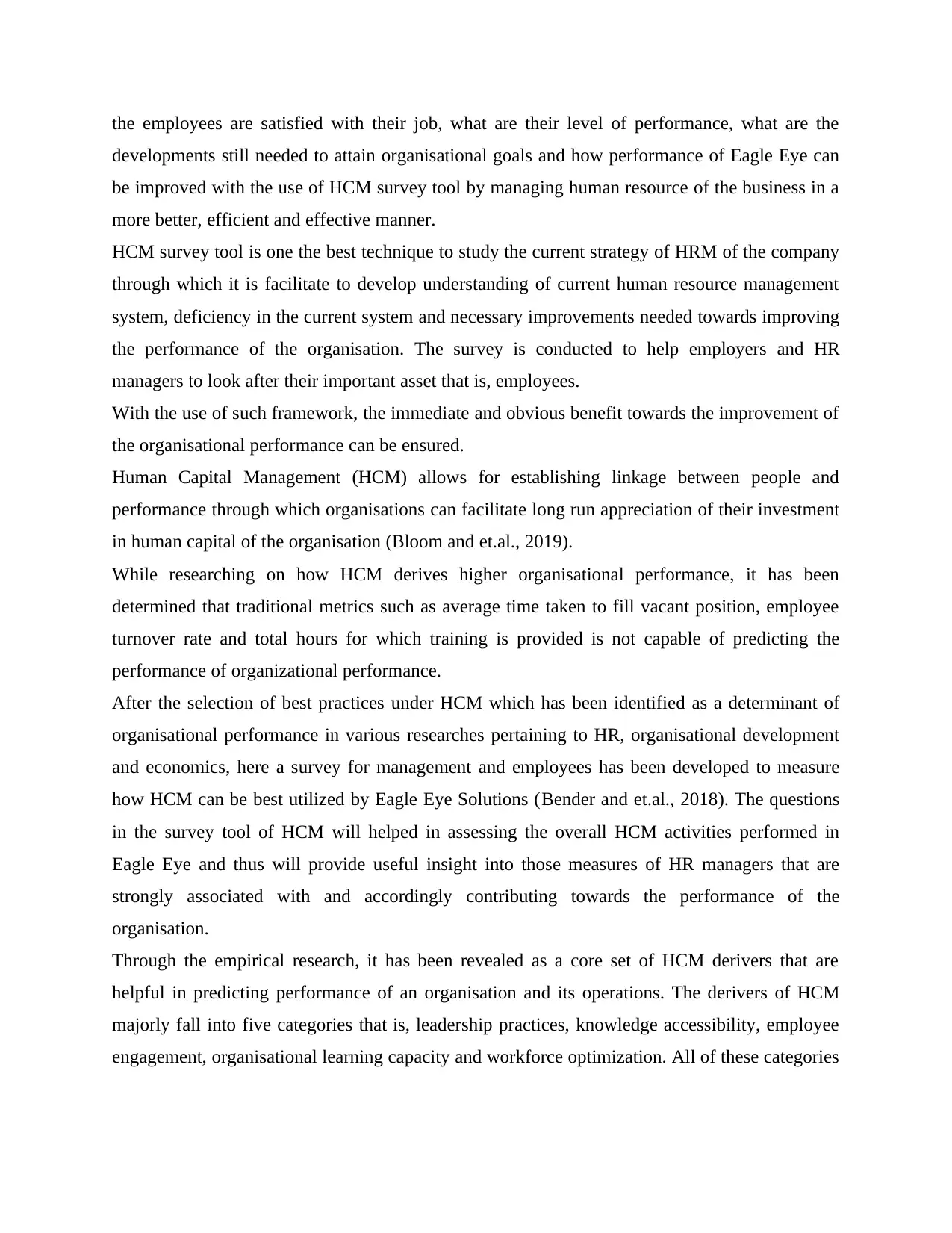
the employees are satisfied with their job, what are their level of performance, what are the
developments still needed to attain organisational goals and how performance of Eagle Eye can
be improved with the use of HCM survey tool by managing human resource of the business in a
more better, efficient and effective manner.
HCM survey tool is one the best technique to study the current strategy of HRM of the company
through which it is facilitate to develop understanding of current human resource management
system, deficiency in the current system and necessary improvements needed towards improving
the performance of the organisation. The survey is conducted to help employers and HR
managers to look after their important asset that is, employees.
With the use of such framework, the immediate and obvious benefit towards the improvement of
the organisational performance can be ensured.
Human Capital Management (HCM) allows for establishing linkage between people and
performance through which organisations can facilitate long run appreciation of their investment
in human capital of the organisation (Bloom and et.al., 2019).
While researching on how HCM derives higher organisational performance, it has been
determined that traditional metrics such as average time taken to fill vacant position, employee
turnover rate and total hours for which training is provided is not capable of predicting the
performance of organizational performance.
After the selection of best practices under HCM which has been identified as a determinant of
organisational performance in various researches pertaining to HR, organisational development
and economics, here a survey for management and employees has been developed to measure
how HCM can be best utilized by Eagle Eye Solutions (Bender and et.al., 2018). The questions
in the survey tool of HCM will helped in assessing the overall HCM activities performed in
Eagle Eye and thus will provide useful insight into those measures of HR managers that are
strongly associated with and accordingly contributing towards the performance of the
organisation.
Through the empirical research, it has been revealed as a core set of HCM derivers that are
helpful in predicting performance of an organisation and its operations. The derivers of HCM
majorly fall into five categories that is, leadership practices, knowledge accessibility, employee
engagement, organisational learning capacity and workforce optimization. All of these categories
developments still needed to attain organisational goals and how performance of Eagle Eye can
be improved with the use of HCM survey tool by managing human resource of the business in a
more better, efficient and effective manner.
HCM survey tool is one the best technique to study the current strategy of HRM of the company
through which it is facilitate to develop understanding of current human resource management
system, deficiency in the current system and necessary improvements needed towards improving
the performance of the organisation. The survey is conducted to help employers and HR
managers to look after their important asset that is, employees.
With the use of such framework, the immediate and obvious benefit towards the improvement of
the organisational performance can be ensured.
Human Capital Management (HCM) allows for establishing linkage between people and
performance through which organisations can facilitate long run appreciation of their investment
in human capital of the organisation (Bloom and et.al., 2019).
While researching on how HCM derives higher organisational performance, it has been
determined that traditional metrics such as average time taken to fill vacant position, employee
turnover rate and total hours for which training is provided is not capable of predicting the
performance of organizational performance.
After the selection of best practices under HCM which has been identified as a determinant of
organisational performance in various researches pertaining to HR, organisational development
and economics, here a survey for management and employees has been developed to measure
how HCM can be best utilized by Eagle Eye Solutions (Bender and et.al., 2018). The questions
in the survey tool of HCM will helped in assessing the overall HCM activities performed in
Eagle Eye and thus will provide useful insight into those measures of HR managers that are
strongly associated with and accordingly contributing towards the performance of the
organisation.
Through the empirical research, it has been revealed as a core set of HCM derivers that are
helpful in predicting performance of an organisation and its operations. The derivers of HCM
majorly fall into five categories that is, leadership practices, knowledge accessibility, employee
engagement, organisational learning capacity and workforce optimization. All of these categories
⊘ This is a preview!⊘
Do you want full access?
Subscribe today to unlock all pages.

Trusted by 1+ million students worldwide

are subdivided into at least four groups. Like for example employee engagement includes those
related to job design, time, commitment and systems.
There are overall 23 practices falling with five broad categories of HCM derivers by assessing
which monitoring of organisational performance can be established (Tigere, 2018). Also,
strengths and weaknesses of the organisation in its human capital management can be assessed in
the best way.
As per the study conducted by 1, it has been determined that decline and improvement in
organisational performance can be directly tied with the improvement or decline in practices
adopted under HCM.
With the rigorous use of such a designed survey which undertakes to score organisation on an
each and every practices adopted in HCM under five broad categories of HCM derivers, there is
a higher possibility of benchmarking HCM capabilities of an organisation and accordingly
strengths and weaknesses of HCM can be identified (Nieves and Quintana, 2018). Also, link
between backsliding and improvements in particular HCM practices and shortcomings and
improvements in overall organisational performance can be established.
There will be a maturity score ranging as 1 to 5, which will be stated corresponding to each
practice. For example, if the score on commitment is 1, then this will indicate poor performance
or low maturity whereas a score of 5 shows strong performance or high maturity. Thus, by
conducting such surveys regularly from time to time and obtaining scores for each HCM
practices indicating either progress or regression may Eagle Eye Solution and its management to
decide upon where focus or improvement efforts are needed that will be having a direct impact
on the overall organisational performance.
How the HCM Survey will be implemented in Eagle Eye Solutions to improvise organisational
performance
Just like utilizing six sigma involves continuous improvement of processes on the basis of
feedback obtained, the approach of HCM evaluation can be used in the same way iteratively,
where in the first stage assessment it shows changes needed in HCM that can affect performance
in a positive manner (Hamadamin and Atan, 2019). Accordingly, performance responds as per
the changes, then practices adopted under HCM are re-evaluated which leads to suggestions for
further changes and so on. The evolution of changes in organisational environment can shift
HCM factors that are meant for deriving performance for the organisation. Therefore, by
related to job design, time, commitment and systems.
There are overall 23 practices falling with five broad categories of HCM derivers by assessing
which monitoring of organisational performance can be established (Tigere, 2018). Also,
strengths and weaknesses of the organisation in its human capital management can be assessed in
the best way.
As per the study conducted by 1, it has been determined that decline and improvement in
organisational performance can be directly tied with the improvement or decline in practices
adopted under HCM.
With the rigorous use of such a designed survey which undertakes to score organisation on an
each and every practices adopted in HCM under five broad categories of HCM derivers, there is
a higher possibility of benchmarking HCM capabilities of an organisation and accordingly
strengths and weaknesses of HCM can be identified (Nieves and Quintana, 2018). Also, link
between backsliding and improvements in particular HCM practices and shortcomings and
improvements in overall organisational performance can be established.
There will be a maturity score ranging as 1 to 5, which will be stated corresponding to each
practice. For example, if the score on commitment is 1, then this will indicate poor performance
or low maturity whereas a score of 5 shows strong performance or high maturity. Thus, by
conducting such surveys regularly from time to time and obtaining scores for each HCM
practices indicating either progress or regression may Eagle Eye Solution and its management to
decide upon where focus or improvement efforts are needed that will be having a direct impact
on the overall organisational performance.
How the HCM Survey will be implemented in Eagle Eye Solutions to improvise organisational
performance
Just like utilizing six sigma involves continuous improvement of processes on the basis of
feedback obtained, the approach of HCM evaluation can be used in the same way iteratively,
where in the first stage assessment it shows changes needed in HCM that can affect performance
in a positive manner (Hamadamin and Atan, 2019). Accordingly, performance responds as per
the changes, then practices adopted under HCM are re-evaluated which leads to suggestions for
further changes and so on. The evolution of changes in organisational environment can shift
HCM factors that are meant for deriving performance for the organisation. Therefore, by
Paraphrase This Document
Need a fresh take? Get an instant paraphrase of this document with our AI Paraphraser
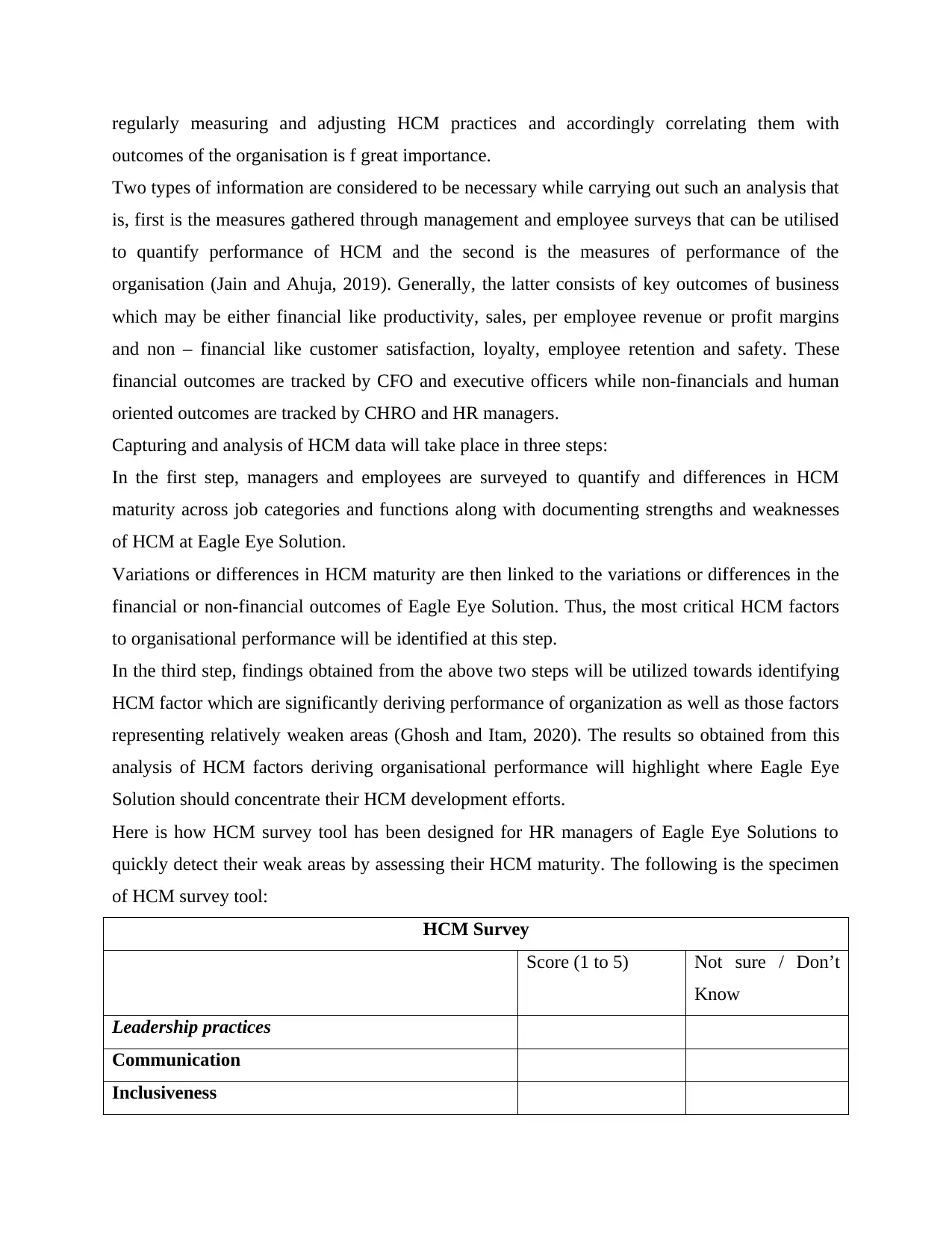
regularly measuring and adjusting HCM practices and accordingly correlating them with
outcomes of the organisation is f great importance.
Two types of information are considered to be necessary while carrying out such an analysis that
is, first is the measures gathered through management and employee surveys that can be utilised
to quantify performance of HCM and the second is the measures of performance of the
organisation (Jain and Ahuja, 2019). Generally, the latter consists of key outcomes of business
which may be either financial like productivity, sales, per employee revenue or profit margins
and non – financial like customer satisfaction, loyalty, employee retention and safety. These
financial outcomes are tracked by CFO and executive officers while non-financials and human
oriented outcomes are tracked by CHRO and HR managers.
Capturing and analysis of HCM data will take place in three steps:
In the first step, managers and employees are surveyed to quantify and differences in HCM
maturity across job categories and functions along with documenting strengths and weaknesses
of HCM at Eagle Eye Solution.
Variations or differences in HCM maturity are then linked to the variations or differences in the
financial or non-financial outcomes of Eagle Eye Solution. Thus, the most critical HCM factors
to organisational performance will be identified at this step.
In the third step, findings obtained from the above two steps will be utilized towards identifying
HCM factor which are significantly deriving performance of organization as well as those factors
representing relatively weaken areas (Ghosh and Itam, 2020). The results so obtained from this
analysis of HCM factors deriving organisational performance will highlight where Eagle Eye
Solution should concentrate their HCM development efforts.
Here is how HCM survey tool has been designed for HR managers of Eagle Eye Solutions to
quickly detect their weak areas by assessing their HCM maturity. The following is the specimen
of HCM survey tool:
HCM Survey
Score (1 to 5) Not sure / Don’t
Know
Leadership practices
Communication
Inclusiveness
outcomes of the organisation is f great importance.
Two types of information are considered to be necessary while carrying out such an analysis that
is, first is the measures gathered through management and employee surveys that can be utilised
to quantify performance of HCM and the second is the measures of performance of the
organisation (Jain and Ahuja, 2019). Generally, the latter consists of key outcomes of business
which may be either financial like productivity, sales, per employee revenue or profit margins
and non – financial like customer satisfaction, loyalty, employee retention and safety. These
financial outcomes are tracked by CFO and executive officers while non-financials and human
oriented outcomes are tracked by CHRO and HR managers.
Capturing and analysis of HCM data will take place in three steps:
In the first step, managers and employees are surveyed to quantify and differences in HCM
maturity across job categories and functions along with documenting strengths and weaknesses
of HCM at Eagle Eye Solution.
Variations or differences in HCM maturity are then linked to the variations or differences in the
financial or non-financial outcomes of Eagle Eye Solution. Thus, the most critical HCM factors
to organisational performance will be identified at this step.
In the third step, findings obtained from the above two steps will be utilized towards identifying
HCM factor which are significantly deriving performance of organization as well as those factors
representing relatively weaken areas (Ghosh and Itam, 2020). The results so obtained from this
analysis of HCM factors deriving organisational performance will highlight where Eagle Eye
Solution should concentrate their HCM development efforts.
Here is how HCM survey tool has been designed for HR managers of Eagle Eye Solutions to
quickly detect their weak areas by assessing their HCM maturity. The following is the specimen
of HCM survey tool:
HCM Survey
Score (1 to 5) Not sure / Don’t
Know
Leadership practices
Communication
Inclusiveness
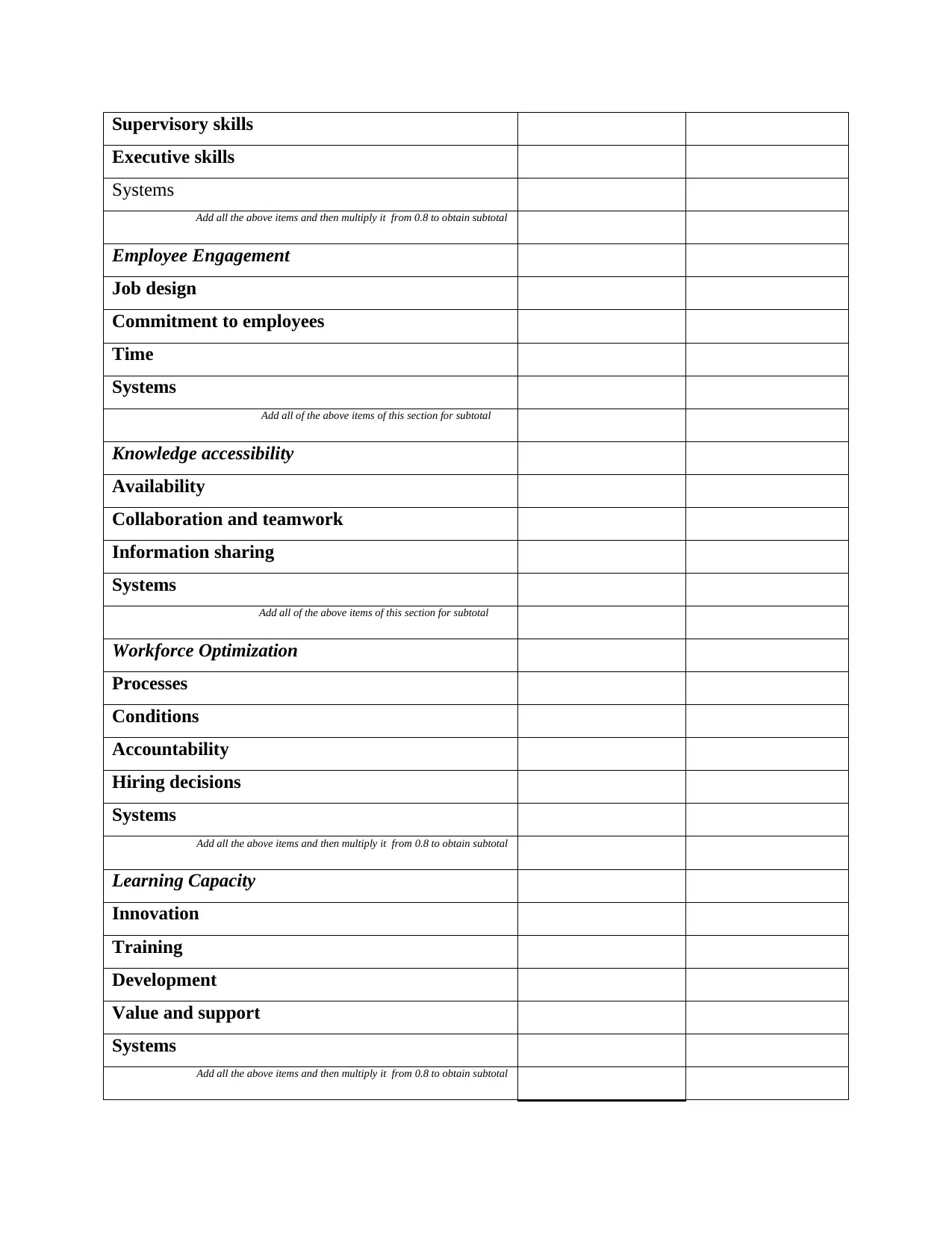
Supervisory skills
Executive skills
Systems
Add all the above items and then multiply it from 0.8 to obtain subtotal
Employee Engagement
Job design
Commitment to employees
Time
Systems
Add all of the above items of this section for subtotal
Knowledge accessibility
Availability
Collaboration and teamwork
Information sharing
Systems
Add all of the above items of this section for subtotal
Workforce Optimization
Processes
Conditions
Accountability
Hiring decisions
Systems
Add all the above items and then multiply it from 0.8 to obtain subtotal
Learning Capacity
Innovation
Training
Development
Value and support
Systems
Add all the above items and then multiply it from 0.8 to obtain subtotal
Executive skills
Systems
Add all the above items and then multiply it from 0.8 to obtain subtotal
Employee Engagement
Job design
Commitment to employees
Time
Systems
Add all of the above items of this section for subtotal
Knowledge accessibility
Availability
Collaboration and teamwork
Information sharing
Systems
Add all of the above items of this section for subtotal
Workforce Optimization
Processes
Conditions
Accountability
Hiring decisions
Systems
Add all the above items and then multiply it from 0.8 to obtain subtotal
Learning Capacity
Innovation
Training
Development
Value and support
Systems
Add all the above items and then multiply it from 0.8 to obtain subtotal
⊘ This is a preview!⊘
Do you want full access?
Subscribe today to unlock all pages.

Trusted by 1+ million students worldwide
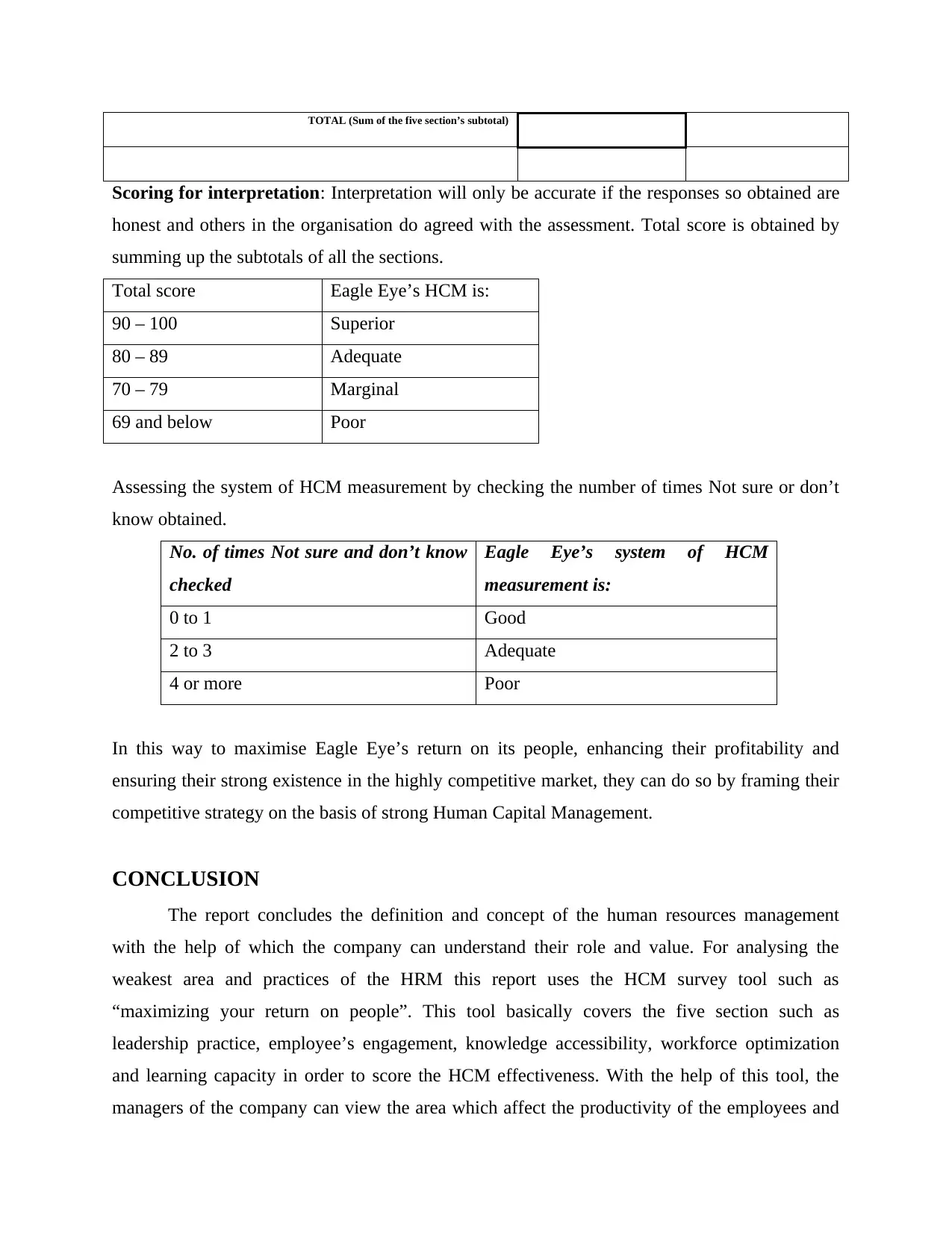
TOTAL (Sum of the five section’s subtotal)
Scoring for interpretation: Interpretation will only be accurate if the responses so obtained are
honest and others in the organisation do agreed with the assessment. Total score is obtained by
summing up the subtotals of all the sections.
Total score Eagle Eye’s HCM is:
90 – 100 Superior
80 – 89 Adequate
70 – 79 Marginal
69 and below Poor
Assessing the system of HCM measurement by checking the number of times Not sure or don’t
know obtained.
No. of times Not sure and don’t know
checked
Eagle Eye’s system of HCM
measurement is:
0 to 1 Good
2 to 3 Adequate
4 or more Poor
In this way to maximise Eagle Eye’s return on its people, enhancing their profitability and
ensuring their strong existence in the highly competitive market, they can do so by framing their
competitive strategy on the basis of strong Human Capital Management.
CONCLUSION
The report concludes the definition and concept of the human resources management
with the help of which the company can understand their role and value. For analysing the
weakest area and practices of the HRM this report uses the HCM survey tool such as
“maximizing your return on people”. This tool basically covers the five section such as
leadership practice, employee’s engagement, knowledge accessibility, workforce optimization
and learning capacity in order to score the HCM effectiveness. With the help of this tool, the
managers of the company can view the area which affect the productivity of the employees and
Scoring for interpretation: Interpretation will only be accurate if the responses so obtained are
honest and others in the organisation do agreed with the assessment. Total score is obtained by
summing up the subtotals of all the sections.
Total score Eagle Eye’s HCM is:
90 – 100 Superior
80 – 89 Adequate
70 – 79 Marginal
69 and below Poor
Assessing the system of HCM measurement by checking the number of times Not sure or don’t
know obtained.
No. of times Not sure and don’t know
checked
Eagle Eye’s system of HCM
measurement is:
0 to 1 Good
2 to 3 Adequate
4 or more Poor
In this way to maximise Eagle Eye’s return on its people, enhancing their profitability and
ensuring their strong existence in the highly competitive market, they can do so by framing their
competitive strategy on the basis of strong Human Capital Management.
CONCLUSION
The report concludes the definition and concept of the human resources management
with the help of which the company can understand their role and value. For analysing the
weakest area and practices of the HRM this report uses the HCM survey tool such as
“maximizing your return on people”. This tool basically covers the five section such as
leadership practice, employee’s engagement, knowledge accessibility, workforce optimization
and learning capacity in order to score the HCM effectiveness. With the help of this tool, the
managers of the company can view the area which affect the productivity of the employees and
Paraphrase This Document
Need a fresh take? Get an instant paraphrase of this document with our AI Paraphraser
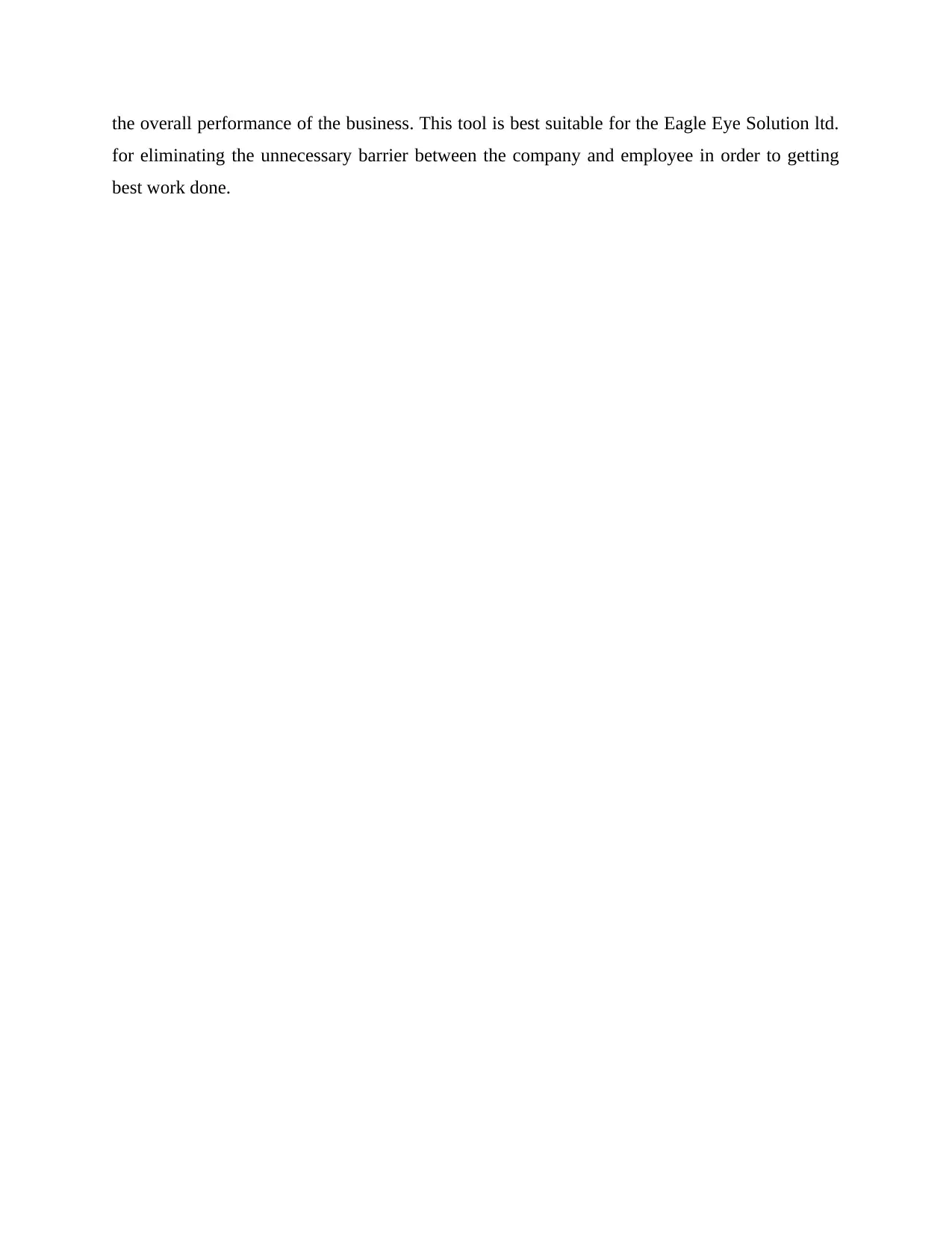
the overall performance of the business. This tool is best suitable for the Eagle Eye Solution ltd.
for eliminating the unnecessary barrier between the company and employee in order to getting
best work done.
for eliminating the unnecessary barrier between the company and employee in order to getting
best work done.
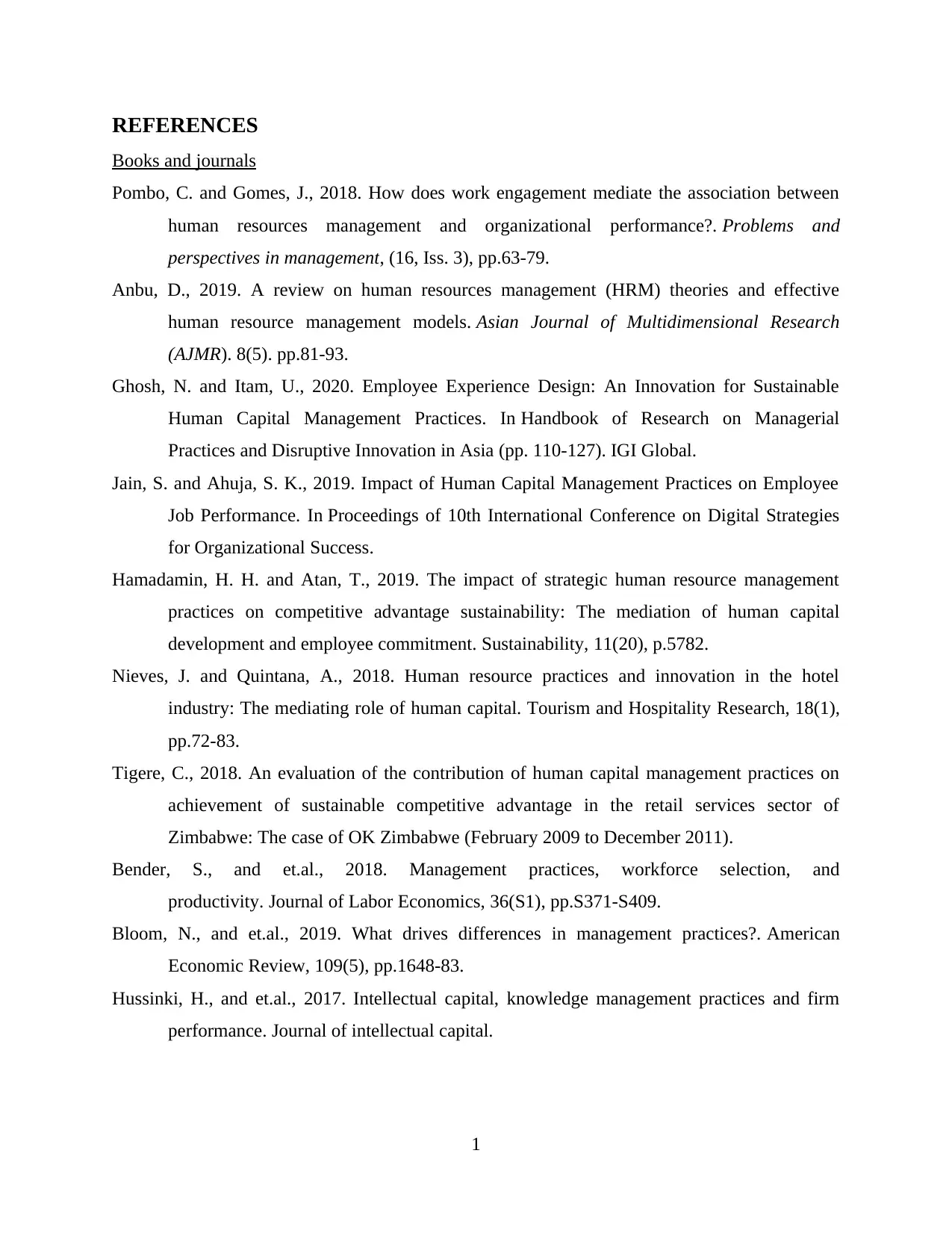
REFERENCES
Books and journals
Pombo, C. and Gomes, J., 2018. How does work engagement mediate the association between
human resources management and organizational performance?. Problems and
perspectives in management, (16, Iss. 3), pp.63-79.
Anbu, D., 2019. A review on human resources management (HRM) theories and effective
human resource management models. Asian Journal of Multidimensional Research
(AJMR). 8(5). pp.81-93.
Ghosh, N. and Itam, U., 2020. Employee Experience Design: An Innovation for Sustainable
Human Capital Management Practices. In Handbook of Research on Managerial
Practices and Disruptive Innovation in Asia (pp. 110-127). IGI Global.
Jain, S. and Ahuja, S. K., 2019. Impact of Human Capital Management Practices on Employee
Job Performance. In Proceedings of 10th International Conference on Digital Strategies
for Organizational Success.
Hamadamin, H. H. and Atan, T., 2019. The impact of strategic human resource management
practices on competitive advantage sustainability: The mediation of human capital
development and employee commitment. Sustainability, 11(20), p.5782.
Nieves, J. and Quintana, A., 2018. Human resource practices and innovation in the hotel
industry: The mediating role of human capital. Tourism and Hospitality Research, 18(1),
pp.72-83.
Tigere, C., 2018. An evaluation of the contribution of human capital management practices on
achievement of sustainable competitive advantage in the retail services sector of
Zimbabwe: The case of OK Zimbabwe (February 2009 to December 2011).
Bender, S., and et.al., 2018. Management practices, workforce selection, and
productivity. Journal of Labor Economics, 36(S1), pp.S371-S409.
Bloom, N., and et.al., 2019. What drives differences in management practices?. American
Economic Review, 109(5), pp.1648-83.
Hussinki, H., and et.al., 2017. Intellectual capital, knowledge management practices and firm
performance. Journal of intellectual capital.
1
Books and journals
Pombo, C. and Gomes, J., 2018. How does work engagement mediate the association between
human resources management and organizational performance?. Problems and
perspectives in management, (16, Iss. 3), pp.63-79.
Anbu, D., 2019. A review on human resources management (HRM) theories and effective
human resource management models. Asian Journal of Multidimensional Research
(AJMR). 8(5). pp.81-93.
Ghosh, N. and Itam, U., 2020. Employee Experience Design: An Innovation for Sustainable
Human Capital Management Practices. In Handbook of Research on Managerial
Practices and Disruptive Innovation in Asia (pp. 110-127). IGI Global.
Jain, S. and Ahuja, S. K., 2019. Impact of Human Capital Management Practices on Employee
Job Performance. In Proceedings of 10th International Conference on Digital Strategies
for Organizational Success.
Hamadamin, H. H. and Atan, T., 2019. The impact of strategic human resource management
practices on competitive advantage sustainability: The mediation of human capital
development and employee commitment. Sustainability, 11(20), p.5782.
Nieves, J. and Quintana, A., 2018. Human resource practices and innovation in the hotel
industry: The mediating role of human capital. Tourism and Hospitality Research, 18(1),
pp.72-83.
Tigere, C., 2018. An evaluation of the contribution of human capital management practices on
achievement of sustainable competitive advantage in the retail services sector of
Zimbabwe: The case of OK Zimbabwe (February 2009 to December 2011).
Bender, S., and et.al., 2018. Management practices, workforce selection, and
productivity. Journal of Labor Economics, 36(S1), pp.S371-S409.
Bloom, N., and et.al., 2019. What drives differences in management practices?. American
Economic Review, 109(5), pp.1648-83.
Hussinki, H., and et.al., 2017. Intellectual capital, knowledge management practices and firm
performance. Journal of intellectual capital.
1
⊘ This is a preview!⊘
Do you want full access?
Subscribe today to unlock all pages.

Trusted by 1+ million students worldwide
1 out of 13
Related Documents
Your All-in-One AI-Powered Toolkit for Academic Success.
+13062052269
info@desklib.com
Available 24*7 on WhatsApp / Email
![[object Object]](/_next/static/media/star-bottom.7253800d.svg)
Unlock your academic potential
Copyright © 2020–2025 A2Z Services. All Rights Reserved. Developed and managed by ZUCOL.




